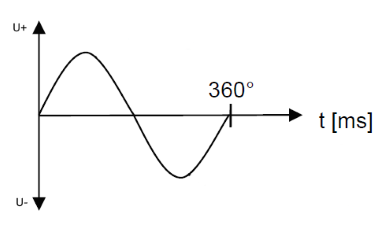Frequency and Period
Calculator and formulas for calculating frequency and period of AC voltages
Period and Frequency Calculator
Frequency-Period Calculator
On this page you can calculate the duration of the period for a certain frequency, or the frequency for a given period. Essential for AC voltage analysis and oscillation calculations.
|
|
Frequency & Period

Period T of a periodic oscillation
Parameters
Basic formulas
Tip
A calculator for calculating frequency and wavelengths can be found here.
|
|
Example calculations
Practical calculation examples
Example 1: Mains frequency (50Hz)
Given: f = 50Hz (European mains frequency)
Example 2: Audio frequency (1kHz)
Given: f = 1kHz (typical test tone)
Example 3: Radio frequency (100MHz)
Given: f = 100MHz (FM radio)
Frequency ranges
Audio frequencies:
Radio frequencies:
Mains frequencies:
Clock frequencies:
Formulas for Frequency and Period
Basic relationships
The frequency is the number of periods per second. It indicates how often a periodic process repeats in one second. The unit of frequency is Hertz (Hz).
The period is the duration of one complete oscillation cycle. It is measured in seconds and is the reciprocal of the frequency.
Frequency formula
The frequency is the reciprocal of the period.
Period formula
The period is the reciprocal of the frequency.
Angular frequency
In addition to the regular frequency, the angular frequency ω (omega) is often used in engineering calculations. It represents the phase change per unit time in radians per second.
Angular frequency formula
The angular frequency is 2π times the regular frequency.
Practical applications
Electrical engineering
- AC power systems
- Motor control
- Filter design
- Resonance calculations
Electronics
- Oscillator circuits
- Clock generation
- Signal processing
- Timer circuits
Communications
- Radio frequencies
- Carrier waves
- Modulation
- Bandwidth calculations
Unit conversions
Common frequency units
Design notes
Practical considerations
- Sampling rate: Must be at least 2× the highest signal frequency (Nyquist theorem)
- Clock accuracy: Crystal oscillators provide precise timing references
- Harmonic content: Non-sinusoidal signals contain multiple frequencies
- Bandwidth: Signal bandwidth determines the frequency range occupied
- Resonance: LC circuits resonate at f = 1/(2π√LC)
- Phase relationships: Multiple frequencies can have complex phase interactions
|
|